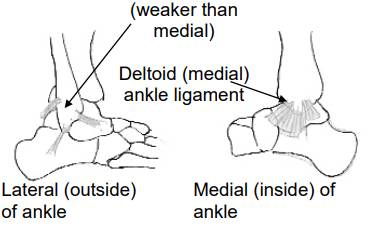Ankle Sprains
Please note, this page is printable by selecting the normal print options on your computer.
Description of Injury
A sprained ankle is one of the commonest musculoskeletal injuries. It can affect people of all ages, and can be the result of a sports injury or a simple trip or twist. A sprained ankle is the result of excessive force being applied to the ligaments that stabilise the ankle joint resulting in damage to their fibres. Following the injury you may hear a pop and invariably pain and swelling result. Bruising becomes obvious over the initial few days and can look significant. It can be painful or difficult to walk. Sprains can be categorised in terms of severity into mild, moderate and severe
depending on the amount of damage to the ligaments.
Treatment Protocol
Most sprains are mild injuries that can be treated nonoperatively with “RICE” treatment:

R – Rest
This will help prevent further injury, and allow the healing process to begin. For the first few days reduce the amount of walking you do and gently exercise the ankle to avoid stiffness. Avoid forceful and strenuous activities such as running or jumping until you can walk without pain. You should weight bear as tolerated and gradually return to activities as symptoms allow.
I – Ice
This helps reduce swelling and pain. You should apply an icepack in a damp towel to the ankle for 10 minutes every two hours initially and may reduce this frequency as the swelling and pain settles.
C – Compression
You may be given an elasticated bandage to wear to support the ankle and reduce swelling. If so, wear it during the day and leave it off at night. The length of time you wear the
bandage can be gradually reduced as your symptoms improve. Most people find they don’t need the bandage within 2-3 weeks of injury.
E – Elevation
You should initially keep the injured ankle above the level of your hips for the first few days after injury to reduce swelling and pain.
Moderate injuries are treated similarly to mild ones, but will take longer to heal. Severe injuries can be associated with ongoing instability. Treatment consists of protected weight bearing in a cast or protective brace for 1-3 weeks, followed by physiotherapy and graded return to function. Your doctor may recommend further investigations such as an ultrasound scan or MRI if symptoms are not improving as expected. Surgery is rarely needed.
Recovery Expected
All ankle sprains recover through 3 phases:
• Phase 1 – resting, protecting the ankle and reducing the swelling
• Phase 2 – restoring the range of movement, strength and flexibility
• Phase 3 – gradual return to activities avoiding those involving sharp turns or twists followed by return to all activities as symptoms allow
In most ankle sprains this process takes 4-6 weeks, but the more severe the injury, the longer it will take. Return to sport and manual work should be expected to take the full 4-6 weeks.
Exercises to aid recovery
Most mild and moderate injuries do not need formal physiotherapy, but may benefit from early exercises. Formal physiotherapy may be indicated in some moderate and most severe sprains.
Ankle stretches
Once the initial pain and swelling is beginning to settle and you can tolerate weight bearing you should start doing ankle stretches to help regain your range of movement. Perform the exercises below twice a day.
• Seated with your leg hanging down:
Bring your ankle and foot all the way up as far as you can slowly, feeling your calf stretch. Hold for 5 seconds, and then point your foot away from you as far as possible and hold for 5 seconds. Repeat this 10 times.
Keeping your knee still, bring your ankle down and in so that the sole of your foot points inwards (inversion). Hold for 5 seconds and repeat 10 times.
Bring your ankle up and out (eversion). Hold for 5 seconds and repeat 10 times.
• Seated on a chair with your feet flat on the floor:
Slide the foot of your injured ankle along the floor behind you keeping your foot on the floor. Repeat 10 times.
Try to keep your ankles directly below your knees if possible. Raise the front parts of your feet off the floor keeping your heels on the floor. Hold for 5 seconds and lower. Now raise your heels off the floor keeping the balls of your feet on the floor. Hold for 5 seconds and lower. Repeat 10 times.
Possible complications
Rarely those with ankle sprains can develop long term instability problems. If pain doesn’t settle down within 6 weeks or you develop symptoms of giving way or ankle instability, further clinical review is needed.
Symptoms can be due to damage to the cartilage of the ankle joint or failure of the ligaments to heal. In such a circumstance your surgeon may recommend an MRI scan to see if surgery such as ligament reconstruction or ankle arthroscopy is indicated.
Where to go for more help / information
If you have any further questions or concerns please contact your GP or the fracture clinic (Monday-Friday 9am-5pm) on 01908 995185.
